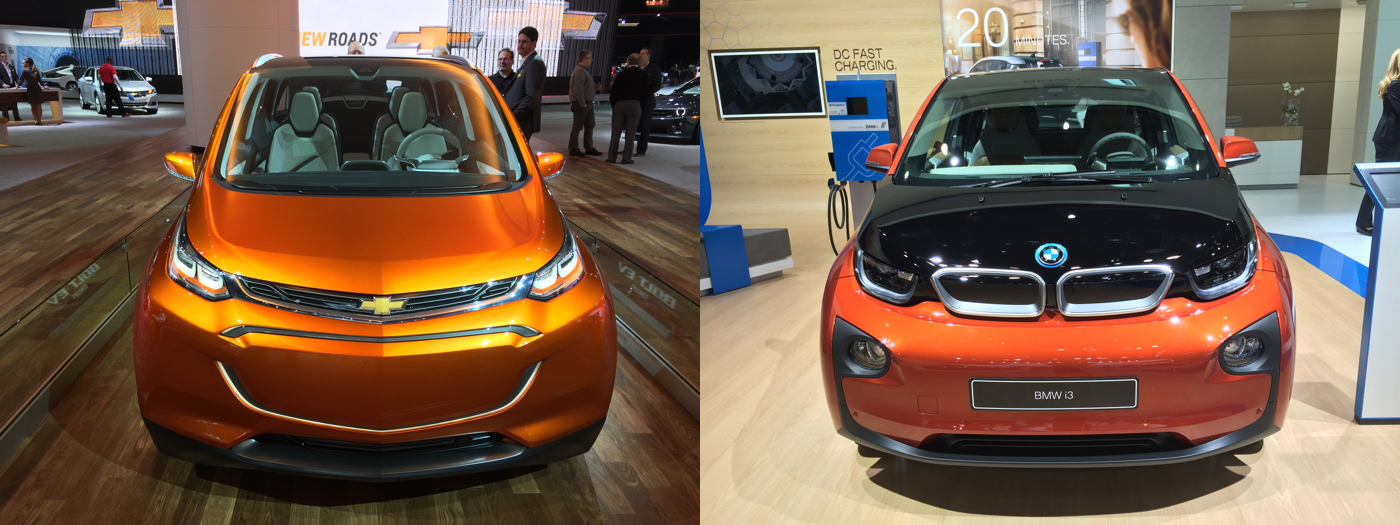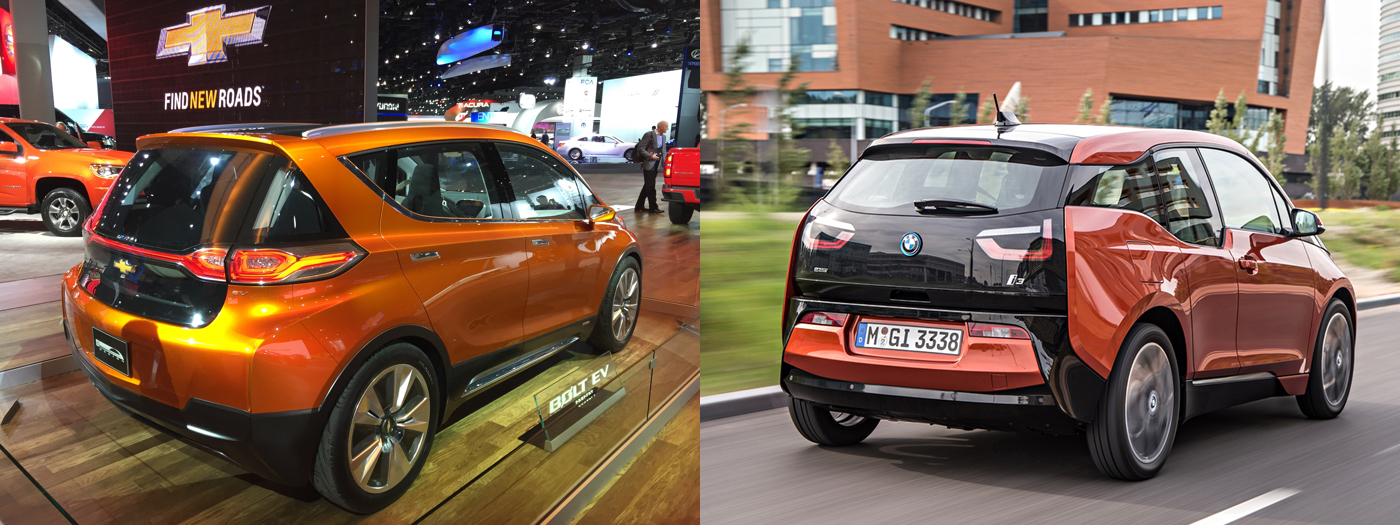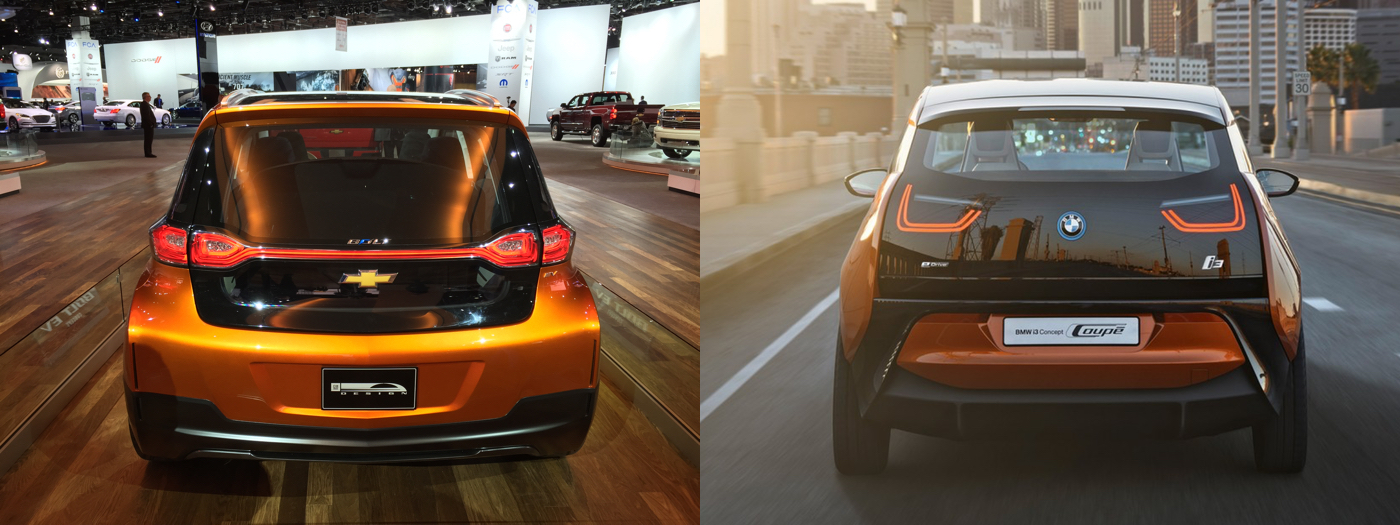A lot of people have started comparing the Chevy Bolt (the concept vehicle unveils alongside the 2016 Volt) and the BMW i3. It seems this is primarily because they have a similar form factor and the fact that both are available with a purely electric drive, although the i3 does have an optional range extender (or REX). It’s important to remember that the Bolt, (which won’t be available for at least two to two-and-a-half years) is a concept vehicle and consequently may look a lot different, when it becomes a production vehicle. Because the Bolt is slated so far into the future, it’s easy to say it will have an electric range of 200 miles, while the final mileage may vary (along with everything else).
Therefore, comparing these two vehicles too closely isn’t really fair, but it is something people are won’t to do, so here are some images to compare them. Most of the images, I shot at NAIAS, but the i3 was in a cramped area that prevented me from getting the exact same views. In two cases, I have to find images rather than shoot them myself. In the case of the passenger side view of the i3, I had to utilize a wide-angle lens and the distortion is apparent.










Like the Bolt styling over the i3. How about some interior shots?
The drivetrain engineer, with whom I had brunch, said the interior was just for show. It probably isn’t close to what the final product will be two-and-a-half years from now. With all the changes I’m seeing in the Chevy infotainment systems, I believe it. That being said, I’ll see what I’ve got and post some.
The Bolt is much sharper looking and it appears to have no blind spots.
the Bolt looks much better in this pics but I have not checked them live yet
CUVs or SUVs?
Are you people all blind. This is an obvious rip off of the i3. It’s like saying, “mm I really like this Xiaomi styling so much better than the iPhone.” Come on. This is a perfect illustration of what got GM into their last bit of trouble. A car company with almost a complete lack of creative automotive engineering going on. The Volt is a rat turd that is built on a pre-existing awful to start with platform. 30-40 miles of true electric range, then an engine directly powering the electric motors, shit a classic hybrid is more efficient. And I’m sure this will be as original as its name suggests. “Bolt”. Model name confusion much. Lest we forget, this is just a flipping concept, the i3 is already available in its second full year of production.
Lance, I’d beg to disagree with you on multiple points:
First, the Volt is an amazing vehicle. I have three of them currently, and could not be happier with their performance and low cost of ownership. Consumer Reports’ annual customer satisfaction survey placed the Volt in the top 10 of all vehicles sold in the U.S., in the company of the Tesla Model S (the only other plug-in to make the top 10), the Corvette Stingray, the Porsche Boxster and the BMW 328D.
Next: a “classic hybrid” is only more efficient over long distances. A Prius owner can get 50MPG if they are very careful in their driving. When gas was $3.30 per gallon, I got the dollar equivalent of 120MPG, and I drive in Sport Mode 100% of the time. Even with gas at $2.00 per gallon, I’m currently getting the dollar equivalent of 80MPG.
General Motors did a great job designing a practically bulletproof battery pack and sizing it just right to balance cost against utility. 80% of U.S. commuters drive 40 miles per day (or less), which would allow them to drive without gas a large majority of the time. I’m currently at 92% electric vs. only 8% gas. Giving the Volt a larger battery pack would have made it too expensive for most consumers, add additional weight, reducing efficiency, and the additional range would have been wasted, as most commuters would get back home with more miles left in the battery pack.
Yes, the i3 is in production, but the range extender is optional (at a high price), the gas tank only holds 2 gallons, so it’s crippled as far as long-distance driving goes and it doesn’t have a 200 mile range (yet). General Motors isn’t trying to compete with the i3, it’s trying to bury it. Tesla has been talking about a 200 mile electric for $30K for several years now. General Motors has drawn a line in the sand and revealed the date they’re going to produce it. Nissan has chimed in as well, saying they’ll have one too. Competition like this is great for consumers.
Obviously, I think the two look similar, but I also think the Bolt (I hate the name too) has done a better job than BMW on the aesthetics and practicality (no reversed back doors, no funky window shape). I’ll grant that they’re both crossovers and it was unfortunate (or provocative) that General Motors made the concept vehicle the same color as the i3 show car. Perhaps it’s GM’s way of saying, “Look how much lower our crossover’s price is, compared to what you can buy today.”